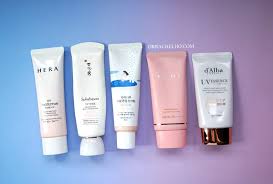What is Cream Skin? The New Korean Beauty Trend of 2024
Cream skin has been called the biggest skincare trend of 2024. Supposedly, beauty prognosticators have their sights set on this look, and it’s moving full speed ahead. But what is cream skin? Is it right for you and your skin? How do you achieve this look? Well, don’t worry, I’m here to clear it all up and help you try out the latest beauty trend for yourself.
What is cream skin?
You’re probably familiar with the skin trend of 2023, glass skin, the ultimate glowing skin. This look comes straight from Korean skincare, a routine we’re all obsessed with that requires all kinds of layered lotions, serums, essences, toners, moisturizers, masks, the list is endless. The result? A face that glows with a healthy glow, like you just stepped out of the spa. It’s been seen countless times on fashion shows and editorial shoots over the past year. The look has become so popular that it’s made its way into our daily lives that we’ve all tried it at least once. And while we may look like we’re having a water fight…
Cream skin is a modern trick, and it’s proving to be a much easier look to achieve. Don’t let the name fool you, it’s not a thick layer of products, quite the opposite as the number of products used to create the look is much less than a glass skin routine.
Aside from Cream Skin, there is a trend towards a reduction in our skincare routines. For a long time now, the amount of time, effort and products used in our regimes has slowly become more complicated and even a bit all-consuming. Well, I don’t know about you, but such a tedious routine, especially after a long day, completely loses the fun. Cream Skin Crazed has found the perfect time for us to put an end to this overdone 10-step routine (and maybe more)!
How to get cream skin?
Compared to the previous 10 products, Cream Skin reduces all cleansing tasks to no more than 3 if you want to make it your basic, simplest daily regimen.
Start with a thorough cleansing of the face. Remove all traces of makeup and dirt using a milky non-foaming cleanser and a warm washcloth to wipe away the residue. This will leave the skin soft and the pores unclogged, ready for the next step.
Next, pour an exfoliating lotion onto a cotton pad and gently wipe over your face, avoiding the eye area. Let the toner do the work for you, so don’t worry about wiping it off.
The next step is completely up to you, but you’ll notice your skin becomes hydrated again when you apply a serum, especially if it contains hyaluronic acid.
The final step is to use a light lotion or moisturizer to hydrate the skin and give it a dewy look, but not the megawatt glow of a glass skin look. Skin Defense Balm is great for nourishing the skin without clogging it up by applying too much product on it.
If you feel it’s necessary, then other steps like eye cream, lip balm, and a mask would be a great addition to your routine, but not essential.
The steps you take after that are also up to you: enjoy the healthy glow of your new “creamy skin” or go for makeup. However, if you decide to use makeup, keep the product even and smooth. From CC cream to cream blush and highlighter. Try not to undo all the hard work you put into getting smooth skin by giving it a matte effect with full-coverage makeup.
How will my skin change if I use a cream skincare routine?
If you’re used to a skincare routine that requires multiple steps, you might be a little hesitant about the simple, streamlined idea of cream skin. However, you’ll be surprised to find that your skin doesn’t look and feel any worse. It’ll love you for the truth: when you master a simple routine with the right products and ingredients, your face will look and feel flawless! As the saying goes, “less is more,” and keeping it simple is the answer to any skin issues you may have.
Will cream skin last?
With beauty forecasters noting a trend toward increasingly streamlined beauty routines, it’ll be interesting to see how the way we shop for skincare changes. Take a “less is more” approach and look for products that will give you the effects described on the fancy packaging. Whether you prefer more natural plant extracts and more botanical products, or you go for the science and opt for those amazingly clever acids and ingredients.
Whatever it is, you’ll be surprised at how your skin will look when you spend more time finding products that work for you and your skin, and less time using them. That leaves you with more free time to do more important things, like actually enjoying your morning coffee!
DQH Can I use salicylic acid first and then vitamin C?
It’s easy to create a skincare routine, but knowing how to use it is another thing entirely. In most cases, if you’re not getting the desired skin results, it could be due to the layering of conflicting ingredients. So, is it possible that salicylic acid and vitamin C are such ingredients? Or are these active ingredients the duo that’s been missing from your skincare routine? If you want answers, stick around because today we are going to explain the benefits of salicylic acid and vitamin C and how they can be used in your daily life.
What are the benefits of salicylic acid for skin?
Salicylic acid is one of the most commonly used beta hydroxy acids and is favored by many people with oily, acne-prone skin. This acid is derived from willow bark, and unlike its water-soluble relatives (called alpha-hydroxy acids), salicylic acid is oil-soluble, which means it can penetrate deeper into the lower layers of the skin. Once it reaches the lower layers, it can help unclog pores of excess sebum, dirt, bacteria, debris, and impurities. This results in clearer skin tones and greater definition.
Not only does salicylic acid benefit the underlying layers, but the outer surface of the skin benefits as well. When applied to the skin, salicylic acid removes the buildup of dead skin cells. This is accomplished by breaking the bonds that hold dead cells to the surface. Over time, this can cause the complexion to look dull and prone to acne, blackheads, and other blemishes.
If you’d like to learn more about salicylic acid and how it can improve your skin, check out this dedicated blog post from a beauty insider.
What are the benefits of vitamin C for skin?
Vitamin C is considered one of the most powerful antioxidants, which means it is very effective at fighting free radicals and preventing them from causing further skin damage. Examples of free radicals include pollution, central heating, UV rays and harsh climate. They attack proteins, fats and cell membranes as soon as they come into contact with the skin, causing signs of premature aging such as fine lines and wrinkles as well as hyperpigmentation, flaky patches of skin and loss of elasticity.
Many people usually prefer to use vitamin C in their morning routine as this ingredient gives the complexion a radiant glow. You’ll also find that vitamin C can target areas of hyperpigmentation, plumping the skin and reducing the appearance of fine lines and wrinkles.
The thing about vitamin C is that there are a lot of outdated studies going back to the 1950s that describe vitamin C as an unstable skin component. Thanks to improvements in modern technology, this is no longer the case as all products now contain a stable form of vitamin C.
Visit The Beauty Insider to learn more about vitamin C. So please check out our blog post.
Can I use salicylic acid first and then vitamin C?
Yes, you absolutely can. In fact, it’s thought that using salicylic acid before using vitamin C ensures it penetrates faster and works faster.
This is an efficient way to utilize two power sources, and the reason has to do with pH. For example, the skin’s natural pH is about 4.7, making it slightly acidic. Salicylic acid and vitamin C are also both acidic, and you’ll find that vitamin C is absorbed quickly into the skin. Therefore, using salicylic acid beforehand can increase the acidity of the skin and allow vitamin C to penetrate into the skin faster.
While this is considered an effective way to combine two powerful ingredients, you need to be aware of your skin type and how it reacts to certain active ingredients. Even people with perfect, normal skin can experience skin sensitivity and irritation. Therefore, always consult a doctor or dermatologist before using any new products on your skin.
It’s also important to follow skin application rules. In this case, you need to use the product correctly to ensure you get the best results for your skin. If you’re not sure what I mean, the basic rule for skin is to start with the thinnest consistency and work your way up to the thickest consistency. This prevents a barrier from forming on the surface, preventing other active ingredients from penetrating the skin.
Can I use salicylic acid at night and vitamin C in the morning?
Yes, absolutely, this is considered the most effective way to get returns without any adverse side effects. This is because there is enough time between applications to ensure that the skin’s pH levels return to balance.
You’ll also find that Vitamin C is rich in antioxidants and is perfect for use in the morning to ensure your skin is protected and looking its healthiest. Due to the small size of salicylic acid molecules, it is an acid that is able to reach the deepest parts of the skin. While this is effective at keeping skin clear, it also increases the risk of irritation and photosensitivity. Therefore, many people prefer to use powerful BHAs in their evening routine without exposure to UV rays, pollution, or harsh weather.
Warning: If you avoid using sunscreen every day, none of these ingredients will do what your skin needs. The combination of chemical peels and powerful ingredients increases the risk of further damage to the skin’s surface. Use SPF 50 every day to keep your skin protected and your lipid barrier healthy, even on cloudy days, keeping your skin in top condition.



